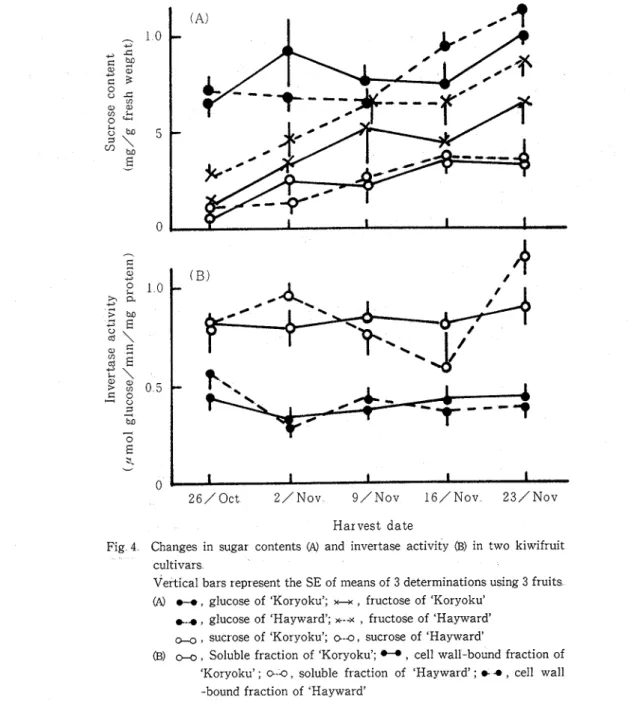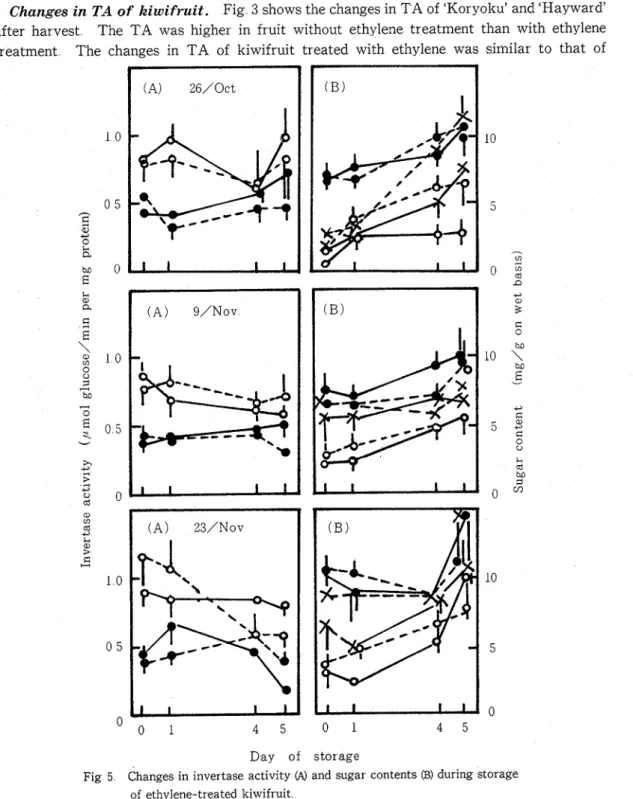Tech Bull Fac Agr Kagawa Univ, Vol 45, No 1, 11-16, 1993
MATURITY EVALUATION O F KIWIFRUIT
DETERMINED ON T H E BASIS O F SUGAR AND ACID CONTENTS
AND COz AND C2H4 PRODUCTION RATES
Toshiyuki MATSUI
This study investigated the COz and C,H4 production rates, titratable acidity (TA),
sugar content and invertase activity of kiwifruits in order to find a suitable harvest index other than soluble solid (SS) content and firmness Kiwifruit exhibited a wide variability in ripening pattern T h e pronounced increase in C2H, production rates did
not coincide with climacteric rise hence the CO, and C2H4 evolved were not used a s the
indication of the ripening These results seem to indicate that kiwifrut has a very weak climacteric type of respiration pattern
"'
T A , sugar content and invertase activity can not be used a s the harvest and ripening indices for kiwifruit due t o the variations observed The changes in starch contents observed in the previous stud?' appear to be a better guide of maturity than T A , sugar content and invertase activityKey Words : Titratable acidity (TA), Soluble solids (SS), Climacteric rise, Sugar con- tent, Invertase activity
Introduction
Since it is difficult to judge maturity of kiwifruits by appearance, degree Brix is used as an indicator of the optimum time to harvest In the previous paper(3), this method appeared to be applicable in 'Hayward' but not in the early-ripening 'Koryoku' This therefore requires finding a suitable index other than SS content, firmness, a-amylase activity and starch content In some fruits, softening commenced just as respiration increased Banana fruits were edible soft shortly after the C02 peak(4' The rates of COz and C2H4 production were measured to determine their relationship with the ripening behavior of kiwifruits with or without C2H4 treatment after harvest
Materials and Methods
Materials Kiwifruit cultivars 'Koryoku' and 'Hayward' were harvested in the fields of a farmer located a t Miki-cho in Kagawa prefecture, Japan Samples were collected from 26th of October to 23rd of November at one week interval Fifty fruits were harvested a t random for each sampling period
Methods Twenty kiwifruits were placed in a 6-1 glass jar, covered with rubber stopper and
injected with CzH4 gas to give a concentration of 1,000 ppm The jar was kept sealed for 15 hr after which the cover was replaced with perforated plastic film Kiwifruits were allowed to ripen a t 20 "C Invertase activity and sugar content were measured a t harvest (0 day) and at 1, 4 and 5 days after C2H, treatment Titratable acidity (TA) was measured at 0, 5 and 10 days after treatment
Tech Bull Fac Agr Kagawa Univ, Vol 45, No 1, 1993
Measurement o f respiration (COz) and ethylene evolution.
In the afternoon of the next day after harvest and daily thereafter for 10 days, each jar containing 1,200 g fruit was kept sealed for 2 hr at 20 "C Headspace COz and C,H, were measured by gas chromatography COz was analyzed by a Hitachi model 164 gas chromato- graph (GC) fitted with a thermal conductivity detector (TCD) and a parallel column (1 m
x
3 mm i d , stainless steel) of 125 cm molecular sieve 13x (60-80 mesh) and activated carbon (60-80 mesh) with helium as carrier gas at a flow rate of 85 ml/min C2H, was also analyzed using the same GC model fitted with a flame ionization detector (FID) and a 100 cm column (1 m x 3 mm i d , stainless steel) of activated alumina (60-80 mesh) Column temperatures of TCD and FID were 80 and 60 "C, respectively The injection port and detector temperatures were 200 "C Each compound in the gas chromatogram was identified by comparing with that of the authentic compoundTA The fruit was cut horizontally into two near the center and 2 cm thick section was
D a y of s t o r a g e Fig 1 Respiration rate a t 20°C of kiwifruit
harvested a t different dates and either treated or non-treated with ethylene Values are means of 8 determinations
0 5 10
D a y of s t o r a g e Fig 2 Ethylene production of kiwifruit har-
vested a t different dates and either treated or non-treated with ethylene Symbols a s shown in Fig 1
using 8 fruits
H , 'Koryoku' with ethylene treat- ment ;
-
, 'Hayward' with ethylene treatment ; 0.0, 'Koryoku' without ethylene t r e a t m e n t ; &-a, 'Hayward' without ethylene treatment'T MAISUI : Maturity evaluation of Kiwifruit (11) 13
taken from the central portion This section was divided into four and squeezed by a hand -held squeezer and the juice was centrifuged at 4,000 rpm for 5 min A 10 ml aliquot was titrated with 0 1 N NaOH using 1 % phenolphtalein as indicator T A is expressed a s citric acid
Extraction and assay o f invertase The methods of extraction were similar to MATSUI
and KITAGAWA'~'
Invertase The assay for invertase was made as in the previous paper(5)
Determination o f sugar Sugar content was analyzed in a similar manner a s in the
previous paper (6)
Results and Discussion
Changes in CO2 and C2H4 production rates o f ethylene-treated and non-treated kiwifruit. Respiration rate of ethylene-treated 'Hayward' reached a maximum 4 days after
treatment both in fruit harvested on the 26th of October and 9th of November (Fig 1) Ethylene-treated 'Koryoku' harvested on the 26th of October exhibited an incraese in COz production rate on the later period of storage Fruits harvested on the 9th of November had
'Kor y oku' Fig 3 'Hayward'
I-"
\ a \-
b
I I2fj/Oct 2/Nov ~ / N o v lfj/Nov 23/Nov H a r v e s t d a t e
Changes in acid content in two kiwifruit cultivars Values are means of 8 determinations using 8 fruits
A, Harvest d a y ; H , with ethylene treatment for 15 h and 5
days storage ; *-a, without ethylene and 5 days storage ; oo,
with ethylene treatment for 15 h and 10 days storage; 0-a, without ethylene and 10 days storage
14 Tech Bull Fac Agr Kagawa Univ, Vol 45, No 1, 1993
its respiratory peak on the 6th day of storage No defined peaks were observed in both ethylene-treated cultivars harvested on the 23rd of November In both cultivars, fruit not treated with CzH4 did not show any distinct respiratory pattern
C2H4 production of both cultivars was low during the early harvest (Fig 2) Ethylene -treated 'Koryoku' harvested on the 9th and 23rd November had the highest CzH4 production rate However, the peak C2H4 production of fruit harvested on the 9th of November occurred earlier than those harvested on the 23rd of November 'Hayward', on the other hand, did not exhibit any increase in C2H4 production The pronounced increases in C2H4 production did not
H a r v e s t d a t e
Fig 4 Changes in sugar contents (A) and invertase activity (B) in two kiwifruit cultivars
Vertical bars represent the SE of means of 3 determinations using 3 fruits (A) H , glucose of 'Koryoku'; X+ , fructose of 'Koryoku'
*.a, glucose of 'Hayward'; *--X , fructose of 'Hayward'
-
, sucrose of 'Koryoku'; 0.0, sucrose of 'Hayward'(B)
-
, Soluble fraction of 'Koryoku'; H , cell wall-bound fraction of'Koryoku' ; 0-0, soluble fraction of 'Hayward' ;
*
, cell wallT MATSUI: Maturity evaluation of Kiwifruit (11) 15
coincide with that of COz evolution It appeared that attainment of climacteric peak cannot be used a s a suitable index of ripening The changes in starch content which we have reported in our previous paper(3' seemed to be a better indication of fruit ripening
Changes in TA o f kiwifruit. Fig 3 shows the changes in T A of 'Koryoku' and 'Hayward'
after harvest The T A was higher in fruit without ethylene treatment than with ethylene treatment The changes in T A of kiwifruit treated with ethylene was similar to that of
.
(A)
26/0ct(B)
I
1 I
D a y of s t o r a g e
Fig 5 Changes in invertase activity (A) and sugar contents (B) during storage of ethylene-treated kiwifruit
(A) Symbols a s shown in Fig 4 (B) (B) Symbols a s shown in Fig 4 (A)
16 Tech Bull Fac Agr Kagawa Univ, Vol 45, No 1, 1993
firmness and the SS contenQ3' Since the optimum firmness of 'Koryoku' a t edible ripe stage (harvested on 26th of October) was between 5 and 6 days after ethylene treatment, the optimum T A was around 0 6 % Unlike starch content which showed definite changes with maturation and ripening(3), the variations observed with regard the changes in T A showed that it cannot be used a s a clear guide of maturity
Changes in invertase activity and sugar contents o f kiwifruit. Fig 4 shows the
changes in sugar content and invertase activity of the two cultivars a t harvest Sucrose content was highest in these cultivars on 16th of November, whereas that of reducing sugars were highest on 23rd of November The invertase activity in the soluble fraction was higher than that in cell-wall bound fraction Invertase activity at optimum harvest time of 'Koryoku' and 'Hayward' in the soluble fraction was 0 7-0 9, and 0 8-0 9 p mol/min per mg protein, respectively, whereas that in the cell-wall bound fraction was 0 4-0 7, 0 4-0 45 p mol/min per mg protein, respectively (Fig 5) The glucose, fructose and sucrose contents and invertase activity cannot be used a s indices of optimum harvest period in place of starch content
References (1) HASEGAWA Y and YANO M : Changes in vari-
ous components concerning ripening and the occurrence of soft rot during storage of kiwifruit
(Actznzdza delzczosa) : J Jpn Soc Hort Scz , 58
(suppl 2), 606-607 (1989)
(2) M A T S U I , T a n d K I T A G A W A , H : S e a s o n a l changes in a- and 8-amylase activities in rela- tion to starch content in kiwifruit Nzppon Sho-
kuhzn Kogyo Gakkazshz, 36, 334-338 (1989)
(3) MATSUI, T and KITAGAWA, H : Maturity evalu- ation of kiwifruit determined on the basis of starch and pectin contents and related enzyme activities, Nzppon Shokuhzn Kogyo Gakkazshz, 37, 224-229 (1990)
(4) AGRAVANIE, J U , MATSUI, T and KITAGAWA,
H : C h a n g e s in p e c t i n m e t h y l e s t e r a s e , polygalacturonase and pectic substances of eth- anol- and ethylene-treated bananas during ripen- ing, Nzpfion Shokuhzn Kogyo Gakkazshz, 38, 527 -532 (1990)
(5) MATSUI, T and KITAGAWA, H : Changes i n invertase activity in relation to sugar content in kiwifruit, Nzppon Shokuhzn Kogyo Gakkazshz, 35, 856-859 (1991)
(6) MATSUI, T and KITAGAWA, 13 ; Effect of ethyl- ene absorbent on invertase activity of Japanese persimmon fruit, J Jpn SOL Hort S c z , 57, 507 -512 (1988)

